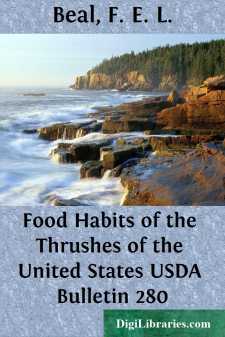Categories
- Antiques & Collectibles 13
- Architecture 36
- Art 48
- Bibles 22
- Biography & Autobiography 813
- Body, Mind & Spirit 142
- Business & Economics 28
- Children's Books 15
- Children's Fiction 12
- Computers 4
- Cooking 94
- Crafts & Hobbies 4
- Drama 346
- Education 46
- Family & Relationships 57
- Fiction 11828
- Games 19
- Gardening 17
- Health & Fitness 34
- History 1377
- House & Home 1
- Humor 147
- Juvenile Fiction 1873
- Juvenile Nonfiction 202
- Language Arts & Disciplines 88
- Law 16
- Literary Collections 686
- Literary Criticism 179
- Mathematics 13
- Medical 41
- Music 40
- Nature 179
- Non-Classifiable 1768
- Performing Arts 7
- Periodicals 1453
- Philosophy 64
- Photography 2
- Poetry 896
- Political Science 203
- Psychology 42
- Reference 154
- Religion 513
- Science 126
- Self-Help 84
- Social Science 81
- Sports & Recreation 34
- Study Aids 3
- Technology & Engineering 59
- Transportation 23
- Travel 463
- True Crime 29
Food Habits of the Thrushes of the United States USDA Bulletin 280
by: F. E. L. Beal
Description:
Excerpt
INTRODUCTION.
North American thrushes (Turdidæ) constitute a small but interesting group of birds, most of which are of retiring habits but noted as songsters. They consist of the birds commonly known as thrushes, robins, bluebirds, Townsend's solitaire, and the wheatears. The red-winged thrush of Europe (Turdus musicus) is accidental in Greenland, and the wheatears (Saxicola œnanthe subspp.) are rarely found in the Western Hemisphere except in Arctic America. Within the limits of the United States are 11 species of thrushes, of which the following 6 are discussed in this bulletin: Townsend's solitaire (Myadestes townsendi), the wood thrush (Hylocichla mustelina), the veery and willow thrush (Hylocichla fuscescens subspp.), the gray-cheeked and Bicknell's thrushes (Hylocichla aliciæ subspp.), the olive-backed and russet-backed thrushes (Hylocichla ustulata subspp.), and the hermit thrushes (Hylocichla guttata subspp.). An account of the food habits of the 5 species of robins and bluebirds appeared in Department Bulletin No. 171.
As a group thrushes are plainly colored and seem to be especially adapted to thickly settled rural districts, as the shyest of them, with the exception of the solitaire, do not require any greater seclusion than that afforded by an acre or two of woodland or swamp.
The thrushes are largely insectivorous, and also are fond of spiders, myriapods, sowbugs, snails, and angleworms. The vegetable portion of their diet consists mostly of berries and other small fruits. As a family thrushes can not be called clean feeders, for the food eaten often contains a considerable proportion of such matter as dead leaves, stems, and other parts of more or less decayed vegetation. It might be supposed that this was gathered from the ground with insects and other food, but investigation shows that much of it has a different origin. It was noticed that the setæ or spines of earthworms were a very common accompaniment of this decayed vegetation. Earthworms themselves are rather rarely found in stomachs, although some birds, as the robin, eat them freely. It is well known that the food of earthworms consists largely of partially decayed vegetable matter found in the soil. Hence it is probable that decayed vegetation found in the stomachs of thrushes is the food contained in the earthworms when they were swallowed. The tissues of worms are quickly digested, leaving the contents of their alimentary canals mixed with the hard indigestible setæ or spines.
Thrushes of the genus Hylocichla show a very pronounced taste for ants, and the average consumption of these insects by the five species is 12.65 per cent. Few birds other than woodpeckers show so strong a liking for this highly flavored food. Hymenoptera in general, including ants, bees, and wasps, are the second largest item of insect food. Lepidoptera (caterpillars) stand next as an article of thrush diet, while Orthoptera (grasshoppers), which are a favorite food with most birds, do not seem to appeal much to the thrushes....


